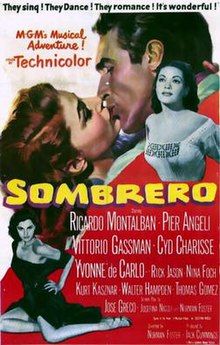Sombrero (film)
| Sombrero | |
|---|---|
 | |
| Directed by | Norman Foster |
| Written by |
|
| Based on | A Mexican Village (novel) by Josefina Niggli |
| Produced by | Jack Cummings |
| Starring | |
| Cinematography | Ray June |
| Edited by | Cotton Warburton |
| Music by | |
| Color process | Technicolor |
| Distributed by | Metro-Goldwyn-Mayer |
Release date |
|
Running time | 103 minutes |
| Country | United States |
| Language | English |
| Budget | $1,821,000[1] |
| Box office | $2,460,000[1][2] |
Sombrero is a 1953 American musical romance film directed by Norman Foster and starring Ricardo Montalbán, Pier Angeli, Vittorio Gassman and Cyd Charisse.
Plot
Three couples involved in budding romances are caught in the middle of a feud between two Mexican villages.
Cast
- Ricardo Montalbán as Pepe Gonzales
- Pier Angeli as Eufemia Calderon
- Vittorio Gassman as Alejandro Castillo
- Yvonne De Carlo as Marìa of the River Road (Maria del lungofiume)
- Cyd Charisse as Lola de Torrano
- Rick Jason as Ruben
- Nina Foch as Elena Cantù
- Kurt Kasznar as Padre Zacaya
- Walter Hampden as Don Carlos Castillo
- Thomas Gomez as Don Homero Calderon
- José Greco as Gitanillo de Torrano
- John Abbott as Don Daniel
- Andrés Soler as Little Doctor
- Fanny Schiller as Doña Fela
- Luz Alba as Rosaura
- Rosaura Revueltas as Zia Magdalena
- Alfonso Bedoya as Don Inocente
Production
The film was based on the 1945 book Mexican Village by Josefina Niggli. It was a collection of 11 short stories set in the north Mexican town of Hidalgo.[3] The New York Times called it "remarkable...one of the finest books about Mexico."[4]
In June 1951, MGM announced they had bought the screen rights as a "possible vehicle for Ricardo Montalbán" and assigned Jack Cummings to produce.[5] In July, Norman Foster was signed to direct and co-write the script with Niggli; the cast was Montalbán, Cyd Charisse and Fernando Lamas, plus one American – Joseph Cotten, Wendell Corey and John Hodiak were the favorites for this.[6] (Both Cummings and Foster had made movies in Mexico.) Eventually the role of an American character was removed.[7] Niggli and Foster collaborated on the script over six months.[7]
In April 1952, Cornel Wilde was being sought for a lead role. By this stage the title of the film had changed from Mexican Village to Sombrero.[8] Vittorio Gassman, Pier Angeli and Ava Gardner joined the cast; it was Gassman's second American film after The Glass Wall.[9] Gardner dropped out in late April and was put on suspension by MGM (lifted when she agreed to make Mogambo).[10]
Then Lamas refused to make the film because it meant going on location in Mexico; MGM suspended him until he agreed to star in The Girl Who Had Everything.[11] By May, Yvonne de Carlo, Nina Foch and Kurt Kaznar joined the cast.[12] Rick Jason joined the cast (presumably replacing Lamas), making his film debut. Dore Schary said he expected Gassmann and Jason to become big stars.[13]
Filming started June 1952. The movie was shot on location in Mexico City, Cuernavaca, Tetecala and Tepoztln, Mexico.[7]
De Carlo did all her scenes with Gassman. "We got along wonderfully," she said. "He's a wonderful actor."[14]
Reception
Box office
According to MGM records, the film earned $1,071,000 in the U.S. and Canada, and $1,389,000 in other markets, resulting in a profit of $592,000.[1]
Proposed follow-up movie
In September 1952, before the film was released, MGM announced Foster would write a follow-up movie based on three or four other stories in the collection Mexican Village that were not used in Sombrero, but no film was made.
References
- ^ a b c The Eddie Mannix Ledger, Los Angeles: Margaret Herrick Library, Center for Motion Picture Study.
- ^ 'The Top Box Office Hits of 1953', Variety, January 13, 1954
- ^ Mexicans of the North: The Bookshelf, W.K.R. The Christian Science Monitor 3 Nov 1945: 20.
- ^ Books of the Times: Easy and Delightful Reading Exotic and Colorful Goings On By ORVILLE PRESCOTT. New York Times 16 Oct 1945: 27.
- ^ METRO WILL FILM 'MEXICAN VILLAGE': Studio Buys Niggli's Novel About Life in Hidalgo as a Story for Montalbán By THOMAS F. BRADY New York Times 5 June 1951: 49.
- ^ Drama: Gloria Swanson Again to Play Actress; 'Strike Match' Bids Laughton, Schallert, Edwin. Los Angeles Times 2 July 1951: B7.
- ^ a b c FOCUS ON 'SOMBRERO' BELOW THE BORDER By JOHN ROTHWELL New York Times 28 Sep 1952: X4.
- ^ 'Julius Caesar' Slated for Summer; Evelyne Asther's Debut Likely, Schallert, Edwin. Los Angeles Times 28 Apr 1952: B9.
- ^ A.F.L. FILM COUNCIL URGES BAN ON REDS: Hollywood Union Group Asks Action 'to Control or Outlaw the Communist Party' By THOMAS M. PRYOR New York Times 23 Apr 1952: 25.
- ^ Film With Spain Locale Named for Cummings; Carey Plans Novel Story Schallert, Edwin. Los Angeles Times 29 Apr 1952: B9.
- ^ LAMAS TO CO-STAR WITH MISS TAYLOR: Metro Lifts Suspension of Actor, Who Will Appear in 'Girl Who Had Everything' New York Times 30 June 1952: 14.
- ^ COURT DENIES PLEA IN JARRICO ACTION New York Times 16 May 1952: 18.
- ^ Looking at Hollywood: Olivia De Havilland Will Star in 'My Cousin Rachel' Film Hopper, Hedda. Chicago Daily Tribune 2 June 1952: a5.
- ^ YVONNE Marches on! Hopper, Hedda. Chicago Daily Tribune 5 Oct 1952: g9.
External links
- Sombrero at IMDb
- Sombrero at the TCM Movie Database
